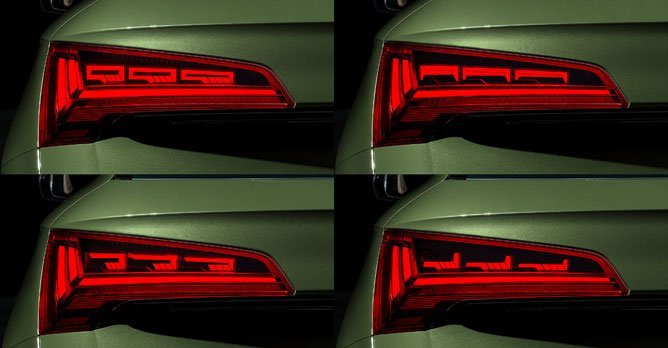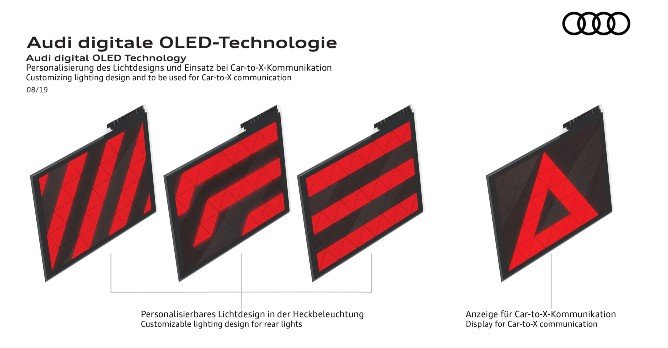 |
In June 2020, the next generation of a lighting technology, digital OLED technology, was premiered in the Audi Q5. With Organic Light-Emitting Diodes (OLED), Audi was a pioneer as far back as in 2016.
This technology promises to improve road safety and is the first to allow for personalisation of the taillight signature. This also marks the brand’s latest milestone achievement in being the first automobile manufacturer to digitise taillights.

The high precision and great variability offer light designers a wealth of opportunities, using just one type of hardware
OLED light sources are panel radiators – unlike point light sources such as LEDs using semiconductor crystals. It is infinitely dimmable and achieves very high contrast and can be split into segments.
These segments are individually controllable and can develop diverse levels of brightness, with minimal gaps between the segments. The lighting unit does not require any reflectors, optical fibers or similar optics. This makes OLED units very efficient, lightweight and flat, which increases design freedom.
An OLED lighting element is just one millimetre thin, while conventional LED solutions require much greater installed depths of 20mm to 30mm. Audi’s OLED technology made its production debut in the taillight of the Audi TT RS in 2016. Up to now, Audi models using OLED lighting technology have had up to four individually controllable, complex lighting segments that could be used for an individual, defined lighting design. The larger number of individually controllable segments can now be randomly activated, with continuous variability of brightness.

Audi shaped the developments around OLEDs in advance, making legislative approval possible for the Q5 despite differences in taillight design
In the Q5, three tiles of six units each, in other words 18 segments per lamp, are currently used. Q5 customers opting for digital OLED technology have a choice of three signatures in the taillights when purchasing their car.
In the new Q5, Audi has implemented a proximity detection feature for the versions using digital OLED taillights. When another road user approaches a stationary Q5 from the rear within less than two metres, all the OLED segments light up. When the Q5 starts to move, it returns to the original light signature.
This is just an initial example of the automobile’s car-to-x communication with its surroundings. Subject to legislative approval, predefined warning symbols are conceivable in the future as well. Going forward, more segments per taillight are conceivable allowing for greater personalisation of signature lighting. For instance, predefined symbols might be displayed to provide other road users with early warnings of hazards such as slippery roads or the tail ends of traffic jams. Thus, the roads are becoming safer with lighting technology from Audi.
The post Audi develops next generation OLED technology appeared first on TinySG.
from TinySG https://tinysg.com/audi-develops-next-generation-oled-technology/?utm_source=rss&utm_medium=rss&utm_campaign=audi-develops-next-generation-oled-technology

No comments:
Post a Comment